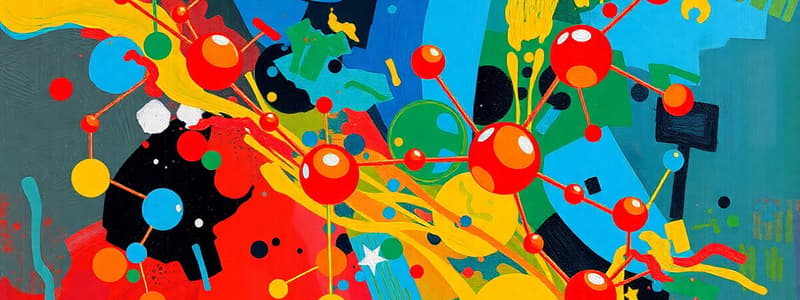Podcast
Questions and Answers
Which of the following is NOT a function of carbohydrates?
Which of the following is NOT a function of carbohydrates?
- Carry genetic information (correct)
- Form part of structural elements of cells & tissues
- Serve as a stored form of chemical energy
- Provide energy through oxidation
The simplest carbohydrate is glyceraldehyde.
The simplest carbohydrate is glyceraldehyde.
True (A)
What is the name given to mirror-image isomers of molecules?
What is the name given to mirror-image isomers of molecules?
Enantiomers
A carbon atom with four different groups attached is called a ______ carbon.
A carbon atom with four different groups attached is called a ______ carbon.
Glucose has 8 isomers.
Glucose has 8 isomers.
What is the name of the two-dimensional representation of mirror-image isomers that is used to simplify their structures?
What is the name of the two-dimensional representation of mirror-image isomers that is used to simplify their structures?
Which of the following is the convention used to categorize sugars based on the position of the hydroxyl group farthest from the carbonyl group in their Fischer projection?
Which of the following is the convention used to categorize sugars based on the position of the hydroxyl group farthest from the carbonyl group in their Fischer projection?
The D family of compounds means that the hydroxyl group farthest from the carbonyl group projects to the left in a Fischer projection.
The D family of compounds means that the hydroxyl group farthest from the carbonyl group projects to the left in a Fischer projection.
Enantiomers can be differentiated based on their different optical activities.
Enantiomers can be differentiated based on their different optical activities.
Which of the following is NOT a key characteristic of stereoisomers in living organisms?
Which of the following is NOT a key characteristic of stereoisomers in living organisms?
What is the term used for carbohydrates composed of two monosaccharide units linked together chemically?
What is the term used for carbohydrates composed of two monosaccharide units linked together chemically?
Match the following carbohydrate classification terms with their corresponding descriptions:
Match the following carbohydrate classification terms with their corresponding descriptions:
Flashcards
Functions of Carbohydrates
Functions of Carbohydrates
- Provide energy 2) Supply carbon 3) Stored energy 4) Structural role
Carbohydrate Definition
Carbohydrate Definition
Polyhydroxy aldehydes or ketones, or substances yielding such on hydrolysis.
Glyceraldehydes
Glyceraldehydes
Simplest carbohydrate, can exist in two isomeric forms (isomers).
Enantiomers
Enantiomers
Signup and view all the flashcards
Chiral Carbon
Chiral Carbon
Signup and view all the flashcards
Stereoisomers
Stereoisomers
Signup and view all the flashcards
Fischer Projections
Fischer Projections
Signup and view all the flashcards
D and L Isomers
D and L Isomers
Signup and view all the flashcards
Optical Activity
Optical Activity
Signup and view all the flashcards
Levorotatory
Levorotatory
Signup and view all the flashcards
Dextrorotatory
Dextrorotatory
Signup and view all the flashcards
Living Organisms and Chiral compounds
Living Organisms and Chiral compounds
Signup and view all the flashcards
Monosaccharides
Monosaccharides
Signup and view all the flashcards
Disaccharides
Disaccharides
Signup and view all the flashcards
Oligosaccharides
Oligosaccharides
Signup and view all the flashcards
Polysaccharides
Polysaccharides
Signup and view all the flashcards
Aldoses
Aldoses
Signup and view all the flashcards
Ketoses
Ketoses
Signup and view all the flashcards
Trioses
Trioses
Signup and view all the flashcards
Tetroses
Tetroses
Signup and view all the flashcards
Pentoses
Pentoses
Signup and view all the flashcards
Hexoses
Hexoses
Signup and view all the flashcards
D-Ribulose
D-Ribulose
Signup and view all the flashcards
D-Glucose
D-Glucose
Signup and view all the flashcards
D-Galactose
D-Galactose
Signup and view all the flashcards
D-Mannose
D-Mannose
Signup and view all the flashcards
D-Arabinose
D-Arabinose
Signup and view all the flashcards
Natural Occurrence of D and L Isomers
Natural Occurrence of D and L Isomers
Signup and view all the flashcards
Stereochemical Role
Stereochemical Role
Signup and view all the flashcards
Study Notes
Carbohydrates
- Carbohydrates have four main functions: providing energy through oxidation, supplying carbon for cell components, serving as a stored form of energy, and forming structural elements in some cells and tissues.
- Carbohydrates are polyhydroxy aldehydes or ketones, or substances that yield these compounds upon hydrolysis.
- Glyceraldehyde, the simplest carbohydrate, exists in two isomeric forms (mirror images) called enantiomers.
- A chiral carbon is a carbon atom bonded to four different groups.
- The carbon atom in glyceraldehyde is chiral, leading to two enantiomers (D and L).
- Enantiomers are nonsuperimposable mirror images.
- Organic molecules, like carbohydrates, may have more than one chiral carbon.
Fischer Projections
- Fischer projections represent molecules in two dimensions to show mirror images.
- L-Glyceraldehyde and D-Glyceraldehyde are enantiomers.
- The D-isomer is when the -OH group is on the right of the chiral carbon.
- The L-isomer is when the -OH group is on the left of the chiral carbon.
- This system helps to determine the D and L configuration of sugars.
- Isomers have the same chemical formula but different spatial arrangement of their atoms.
Physical Properties and Optical Activity
- D and L isomers generally have the same physical properties except for rotation of polarized light.
- Enantiomers that rotate polarized light to the left are levorotatory (-).
- Enantiomers that rotate polarized light to the right are dextrorotatory (+).
- Optical activity is the property of rotating the plane of polarized light.
- Optical activity is useful for differentiating between stereoisomers.
- Stereoisomers are important in living organisms.
Stereoisomers in Living Organisms
- Living organisms often use only one stereoisomer (like L-amino acids).
- D-glucose is a common carbohydrate.
- Not all molecules with chiral carbons only contain one isomer.
Classification of Carbohydrates
- Classification is based on the number of molecules:
- Monosaccharides: one molecule
- Disaccharides: two molecules
- Oligosaccharides: 3-10 molecules
- Polysaccharides: many molecules (hundreds or thousands)
- Monosaccharides are classified by the number of carbons: Trioses, Tetroses, Pentoses, Hexoses and etc.
- Glucose is an aldohexose, a six-carbon sugar with an aldehyde group.
- Ribulose is a ketopentose, a five-carbon sugar with a ketone group
Studying That Suits You
Use AI to generate personalized quizzes and flashcards to suit your learning preferences.





